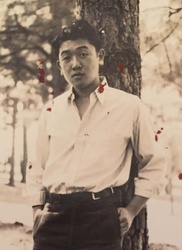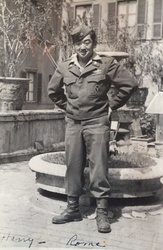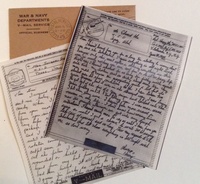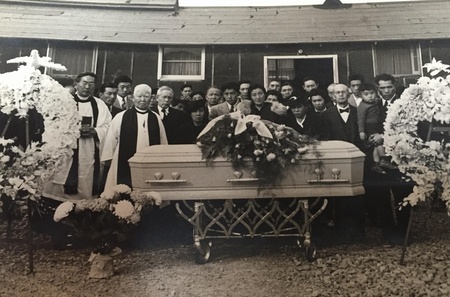Sometime around 1932, Bachan went to the funeral of a family friend in Suisun with a big plate of homemade sushi and came home with three boys.
Their father had been a family friend in Wakayama, and when he first came to the U.S., he had stayed at “Pine” (the Takahashi home on Pine Street in San Francisco) en route to a job in California’s Delta. He had married late like many Issei, but his wife had died some time ago and so it was just Oda-san and the three boys: Henry, Eddie, and Harry.
Now Oda-san was gone. At the funeral, Bachan worried about the boys, huddled together alone. The middle one, Eddie, had an angelic innocence to him and looked to be about the same age as her own son Shig, who was eleven. The other two — Henry, two years older, and Harry, two years younger than Eddie, like bookends — bore a strong family resemblance to each other. They had mobile faces that looked as if the possessor could go either way — be a comedian or a pugnacious rabble-rouser. She noted the “friend of the family” who took charge of collecting the koden, funeral money, given by the guests. Times were hard, but people gave what they could, knowing the favor would be returned when they were the ones in need.
After the service, Bachan talked to some of the other ladies, who told her that the Odas’ “family friend” was not a reliable man. There were no relatives the boys could go to. People in the community were having a hard enough time feeding their own families. The boys would probably end up on the street, or be split up and farmed out to families or employers who needed field hands.
Bachan did not stop to think about her own family: two girls and two boys, ranging in age from nineteen to three, or her own age, which was fifty. She did not think about how fragile their own economic situation was, just a year or so out from a bad stretch that had her contemplating walking into the Pacific Ocean with her baby son (who, as it turned out, did not live to see his first birthday). She didn’t stop to count the bedrooms they had in the Victorian flat that they rented from their Greek landlord. Nor did she think about how their retail business on Grant Avenue was so much better than wholesale — when a retail customer bought something, you had cash in hand — and the store was doing well in its second year of operation.
As soon as she saw that the family friend had disappeared with the koden, she collected the Oda boys and said, “You’re coming home with me.” Still dazed with the loss of their father, they did not protest. They needed an adult to make a decision, and they were relieved.
What her husband, Shigetaro, and her own children — Kiyo, Tomi (my mother), Shig, and Edwin — thought of the sudden acquisition of three more members in their family, no one knows. The Oda boys had a place to sleep and three meals a day; they were clothed and sent to school. Kiyo at nineteen was already out of school and helping at the store. Tomi, fourteen, and Shig, eleven, were the closest to the boys in age. Tomi in particular had lived through the family’s hard times during her formative years and had a natural sympathy for children in need. Edwin was just three and accepted his new brothers easily as three more people to play with.
When we look at old photos from the past, we try to identify the faces in it; but we often don’t notice who is missing. Henry, the eldest Oda boy, is not in this photo of the Takahashis, taken around 1936.

By 1936, there were only two Oda boys. Henry, the eldest, had a nosebleed one day, and a fever. Friends came to give blood; but a week later, he was dead of some form of acute leukemia.
Sometime in his late teens, Eddie contracted tuberculosis and had to stay at Weimar, a sanatorium in Placer County. He eventually recovered, and after the bombing of Pearl Harbor, he was interned with the Takahashis, first at Tanforan, and then Topaz. Despite his delicate health, he was assigned to the very dusty job of distributing mattresses.
Meanwhile, Harry, the youngest, joined up in 1943 and went on to fight in Europe with the 442nd Regimental Combat Team. He saw action in northern Italy in June of 1944.
V-mails (Victory mail) slowly made their way to barrack 4-5-E in Topaz from Harry in the 442 in Italy:
June 30, 1944
To Eddie, 4-5-D, Topaz, Utah
From: Harry, Co. L, 442
I haven’t heard from you in so long I’m starting to worry…
My clothes are so dirty they seem like they may mold...
So far I have taken two Jerries prisoner... I'm telling you I was more scared I bet then they were...
Give my regards to the Takahashis and tell them everything is all right with me, so don't worry...
Jan. 2, 1945
To Tomi (my mother), 4-5-D, Topaz, Utah
From Harry
Thanks for the package...
About all the fellas I know have either been wounded or killed…
Feb. 1, 1945
To Tomi, 4-5-E, Topaz, Utah
From Harry
Oh, quit mentioning "osushi" and "oyako domburi" to me. Every time I even think of it my mouth starts to water...
When I do get back boy "food" watch out!
Feb. 12, 1945
To Eddie, 4-5-D, Topaz, Utah
From Harry
Thought I'd drop you a line since I haven't heard from you in a long while...
I got your package a few days ago. That hair oil, shaving lotion was really something I was hurting for...
Mail to the European front was even more erratic. In February, 1945, Harry received word from my mother that Eddie had had a relapse and died in the Topaz Hospital. Previous attempts to reach Harry by telegram and letter as Eddie’s condition deteriorated had been delayed.
Despite support from his commanding officer, Harry was denied bereavement leave to return to the States.
Harry had often wondered about his own chances of making it through the war, but had never expected to lose his brother. Now he was the only Oda boy left.
March 14, 1945
To Tomi, 4-5-E, Topaz, Utah
From Harry
Tomi, I don't know how to thank you and the folks for all you did for ed and I. I don't know what we would have done without you. Thanks ever so much...
These were the kinds of stories that were withheld, only to come out many years later, or sometimes, not at all. Some stories survive only because the letters did.
In May of 1945, my mother received a last v-mail from Harry:
The miracle has happened! I'm being sent back to the States. Right now I'm in a depot in Naples waiting to catch a boat or airplane back to the States. There's about 65 of us from the 100th and 442nd being transferred to Military Intelligence School at Camp Ritchie, Maryland...
After leaving the army, Harry spent some time in Chicago, where he met his future wife. Her family was living in Los Angeles, and they eventually moved back to the West Coast and raised three children. So Harry lost his entire family at a young age; but in a display of resilience characteristic of so many Nisei of his generation, survived to create his own.
Suisun to Los Angeles, via San Francisco, Italy, and Chicago: the trajectory of a life shaped by fate, a random act of kindness, racial discrimination, and wartime.
*This article is a revised version of Ruth Sasaki's blog posts from May 2018.
© 2019 Ruth Sasaki







